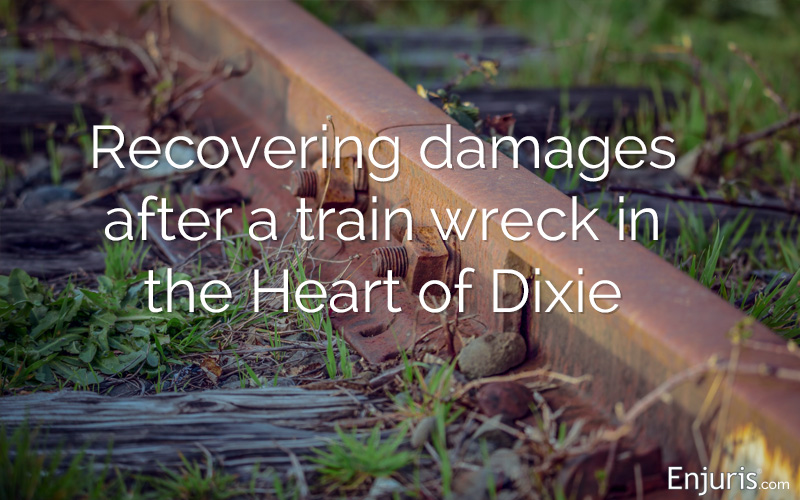
How to recover damages after a train wreck, whether you’re a passenger or railroad employee
During the late 19th century and early 20th century, train travel was incredibly popular in Alabama.
Alabama's first train was a horse-powered system operated by the Tuscumbia Railway in 1830.
Today, Alabama's 4,728 miles of rail are primarily used to haul more than 90 million tons of cargo annually. However, Alabama currently has 2 intercity passenger rail services operated by Amtrak, the Crescent and the Sunset Limited. Both rail services operate on tracks owned by freight railroads.
Alabama train accident statistics
| Alabama train accidents (2015-2020) | ||||||
|---|---|---|---|---|---|---|
| Year | 2015 | 2016 | 2017 | 2018 | 2019 | 2020 |
| Fatalities | 5 | 9 | 9 | 7 | 6 | 2 |
| Injuries | 34 | 42 | 23 | 33 | 36 | 6 |
| Total accidents | 90 | 78 | 66 | 55 | 85 | 84 |
| Source: Alabama Department of Transportation and Federal Railroad Administration Office of Safety Analysis | ||||||
The vast majority of train accident fatalities occur at railroad crossings and are the result of drivers or pedestrians ignoring flashing lights, barrier gates, or other active warning devices.
According to National Highway Traffic Safety Administration, a motorist is almost 20 times more likely to die in a crash involving a train than in a collision involving another motor vehicle.
Common causes of train accidents
The Federal Railroad Administration (FRA), which investigates most train accidents, identified the most common causes of train accidents as follows:
- Track, roadbed, and structure problems
- Signal and communication errors
- Train operation errors (human factors)
- Mechanical and electrical failures
When a train accident happens, it generally takes one of the following forms:
- A pedestrian hit by a train. Most train-related fatalities are the result of a pedestrian being killed while crossing a train track. Unfortunately, many of these accidents are the result of suicide.
- A collision with a motor vehicle. Some train accidents happen when motor vehicle drivers ignore crossing arms and warning lights.
- A train-on-train collision. Collisions between trains are extremely rare but generally catastrophic.
- A derailment. Derailments are actually fairly common, but most don't result in injuries. A derailment happens when a train comes off the tracks. One study found that broken rails or welds were the leading cause of derailments, followed by human factors such as the improper use of switches.
The Big Bayou Canot Disaster
On September 22, 1993, an Amtrak train headed to Miami, Florida derailed near Mobile, Alabama, killing 47 people. The accident, which remains the deadliest in Amtrak's 50-year history, was caused by a negligent towboat operator.
The towboat, operated by Andrew Stabler and Willie Odeon, was pulling 6 barges through the Alabama marshes. Andrew was sleeping as the towboat made its way up the Mobile River. Willie, who was driving the boat, did not know how to use the boat's radar system. What's more, the boat had no compass or nautical charts, which made it difficult to navigate through the foggy night.
Becoming lost, Willie turned into an area where barges are prohibited and struck a 7-foot-high rail bridge designed to take trains over the marshes. The impact knocked the tracks out of alignment by 3 feet.
Shortly after the impact, the Amtrak came over the bridge traveling 70 miles per hour. When the train hit the misaligned tracks, it derailed. All 3 locomotives and the first 4 cars plunged into the cold water.
Who can be sued for a train accident in Alabama?
When a train wreck happens, there are a number of parties who may be liable. These include:
- The railroad company. Train operators and others who work for a train company are responsible for keeping passengers safe. If a railroad company employee fails to do so, the railroad company can be sued for negligence under the doctrine of respondeat superior.
- Railroad employees. A railroad employee may be personally liable for a crash if the actions that caused the crash were intentional or criminal.
- The track owner. Different sections of track could be owned by different companies or government entities. If an accident occurs because of a dangerous condition present on the track, the owner of that section might be liable.
- The manufacturer of the train or track. If the accident occurred because of a defective train or track component, the manufacturer may be liable.
- Motor vehicle driver or pedestrian. If the accident was caused by a driver or pedestrian entering the path of an oncoming train, the driver or pedestrian may be liable.
- Other third parties. Any other party who causes or contributes to the accident, such as the steamboat operator in the Big Bayou Canot rail accident described above, may be liable.
Practically speaking, you don't need to worry too much about who can be held liable for your accident. Your lawyer will review the facts of your case and file a lawsuit against ALL parties who may be at least partially liable for your accident.
How does an injured train passenger recover damages?
If you're an injured train passenger, you may wonder what you need to do to recover damages. Assuming you weren't responsible for the accident, you typically have 2 options:
- File an insurance claim against the at-fault party (assuming they're insured), or
- File a personal injury lawsuit (assuming the at-fault party doesn't have insurance, your damages exceed their policy limits, or their insurer denies your claim).
In most cases, personal injury lawsuits arising from train wrecks will be based on negligence. In Alabama, you need to prove 3 elements to establish negligence:
- Duty. The plaintiff must prove that the defendant owed them a duty of care. A duty of care arises when the law recognizes a relationship between the plaintiff and defendant requiring the defendant to exercise a certain standard of care to avoid harming the plaintiff. A railroad company is considered a "common carrier." A common carrier is obligated to employ the "highest degree of care" for their safety.
- Breach. The plaintiff must prove that the defendant breached the duty of care. A breach occurs when the defendant fails to meet the standard of care required.
- Causation. The plaintiff must prove that their injury was caused by the defendant's breach of the standard of care.
How does an injured railroad employee recover damages?
If a railroad employee is injured in a train accident that was caused by their employer or a colleague, the railroad employee can't file a personal injury lawsuit. Instead, the railroad employee MUST file a Federal Employers Liability Act (FELA) claim.
FELA stands in place of workers' compensation for railroad employees, but there 3 major differences that railroad employees should know about:
- FELA is fault-based, meaning injured railroad employees must prove that their employer was negligent to recover damages.
- The amount of compensation a railroad employee can recover under FELA is not capped.
- Injured railroad employees can recover non-economic damages like pain and suffering under FELA.
How does the family of someone killed in a train crash recover damages?
If someone is killed while riding as a passenger on a train, certain surviving family members may be able to receive compensation by filing a wrongful death lawsuit.
A wrongful death lawsuit is similar to a negligence lawsuit in the sense that you must prove that the defendant's negligence or wrongful act caused your loved one's death. If you're successful, you can recover damages for the emotional and financial loss caused by your loved one's death, including:
- Medical expenses
- Funeral and burial expenses
- Lost wages and income that the person would have likely earned if death had not occurred
- Loss of care, companionship, and other intangible benefits
When a railroad employee is killed at work, a similar lawsuit can be filed under FELA. Available damages under FELA include:
- The conscious pain and suffering of the employee before their death
- Medical expenses
- Funeral expenses
- The pecuniary damages of the surviving family members (for example, the wages and other benefits the family member would have received from the employee had the employee survived)
Statute of limitations for Alabama train accidents
If you intend to file a personal injury lawsuit or wrongful death lawsuit in Alabama, you'll need to do so within 2 years of the train accident. If you intend to file a claim under FELA, you'll need to do so within 3 years of the train accident.
Failing to file your lawsuit within the statute of limitations will result in your claim being forever barred.
Do I need to hire an Alabama train crash attorney?
Train wrecks can be significantly more complex than car crashes and many other types of personal injury accidents.
Train accidents typically involve multiple defendants (often residing in multiple states). What's more, government agencies, such as the FRA will be heavily involved in any case.
If you intend to file a lawsuit or FELA claim, we strongly recommend contacting an experienced train accident attorney. You can find an attorney near you using our free online legal directory.
See our guide Choosing a personal injury attorney.

